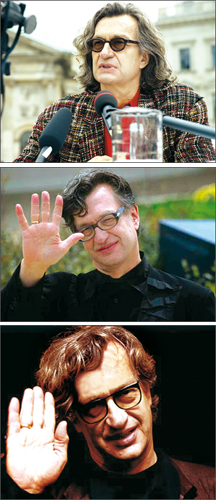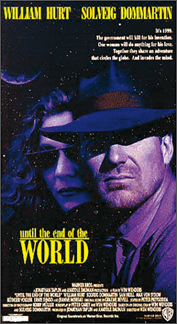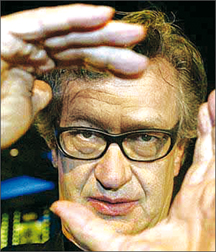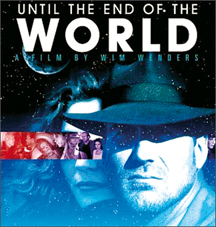Until the end of the world
 Many people hated it, but I am one of the few who loved it. I
couldn't take my eyes off the beautiful Australian landscape. I bought
the sound track album of the movie in 1992 in Stuttgart in Germany. Two
years later I got to see the film at Paul's Apartment in 16th and 7th
avenue. When I got back from my vacation in 1991, it was already 1993, I
did not have a place to stay and Lubna welcomed for me to stay in her
little place with her brother, but when I got there I realized that
place was even too small for them to stay cause I even had my film box
"Veils of Maya" (Sihina Deshayen) with me. Many people hated it, but I am one of the few who loved it. I
couldn't take my eyes off the beautiful Australian landscape. I bought
the sound track album of the movie in 1992 in Stuttgart in Germany. Two
years later I got to see the film at Paul's Apartment in 16th and 7th
avenue. When I got back from my vacation in 1991, it was already 1993, I
did not have a place to stay and Lubna welcomed for me to stay in her
little place with her brother, but when I got there I realized that
place was even too small for them to stay cause I even had my film box
"Veils of Maya" (Sihina Deshayen) with me.
  Then I called Paul, and he said I could come and stay with him as
long as I like, like Lubna who has always been an amazing friend to me,
Paul was the same, except he did not mind try to sleep with most of my
female friends. Well that is Paul. If anyone wants to picture Paul, he
would be the "Dude" from Big Lebowzki the movie by Coen Brothers. Paul
and I go way back to 1988, since I met Andrena, and I became a roommate
with Alexandra Miroshlawa in Jersy City, and all the cool parties me
Paul, Denise and all of us were attending to. Then I called Paul, and he said I could come and stay with him as
long as I like, like Lubna who has always been an amazing friend to me,
Paul was the same, except he did not mind try to sleep with most of my
female friends. Well that is Paul. If anyone wants to picture Paul, he
would be the "Dude" from Big Lebowzki the movie by Coen Brothers. Paul
and I go way back to 1988, since I met Andrena, and I became a roommate
with Alexandra Miroshlawa in Jersy City, and all the cool parties me
Paul, Denise and all of us were attending to.
Paul always had a great vision with colors, I love his paintings the
way he was using his gold and Silver in the paintings. Sometimes I would
buy a pack of Busch beer, which was only fifty cents a can in 1988-89,
would walk up to his apartment and we would drink and smoke a lot.
Then we go into these crazy conversations about the dimensions. We
always talked about fifth dimension. For about months we talked about
it, being so high and comfortable, then one day it hit me, that we have
skipped one dimension and talked about the fifth and we have been
completely off the hook with the dimensions. So we gave up on it being
so disappointed and time wasted.
So I took the liberty of crashing on Paul's couch in the living room
and watching videos in the night. One breezy afternoon in the fall of
1993 I rented "Until the end of the world" from Kim's video at avenue'
next to "Cafe Limbo", and watched it at Paul's apartment.
 It was not as good as Wim Wenders other movies like "Paris Texas",
Wings of Desire or even "American Friend" but visually it was most
stunning and like many Wender's movies, it was a cool road movie. I
think this is the movie that gave me inspiration to make "Buongiorno
Italia" (Mille Soya) as a road movie. The fact the film was shot in many
countries inspired me to write "Mille..." journey through many countries
as well. Since the day I watched "UEOTW" by Wenders, I re-fell in love
with Australia. Just like the time I watched Mad Max 2 the "Road
Warrior". The soundtrack really blew me. It was not as good as Wim Wenders other movies like "Paris Texas",
Wings of Desire or even "American Friend" but visually it was most
stunning and like many Wender's movies, it was a cool road movie. I
think this is the movie that gave me inspiration to make "Buongiorno
Italia" (Mille Soya) as a road movie. The fact the film was shot in many
countries inspired me to write "Mille..." journey through many countries
as well. Since the day I watched "UEOTW" by Wenders, I re-fell in love
with Australia. Just like the time I watched Mad Max 2 the "Road
Warrior". The soundtrack really blew me.
One of my favourite songs of the album was "Death Song" by Depeche
Mode. I told Martin Gore of "DepechieMode" in 93 on our way to "Tunnel"
Club, that I love their song from "Untill The End Of the World". He told
me the story how they came to do it. He said, that day in the middle of
the day his phone rang and when he answered the phone the voice on the
other side said "Hello I am Wim Wenders, I am a filmmaker and I really
would like you to do a song for my movie".
 Martin has said, sorry they are too busy and they can do anything.
Wenders has insisted on them doing a song and finally they could not
believe and he got them to do the song for him. I told Martin that it is
my favourite song of the band. Wim Wenders influenced me a lot to carry
songs through the film. I did so in Mille, just like his, Far Away So
Close, Until the End..., and Million Dollar Hotel. Until The End of the
World is an odyssey for the modern age. Martin has said, sorry they are too busy and they can do anything.
Wenders has insisted on them doing a song and finally they could not
believe and he got them to do the song for him. I told Martin that it is
my favourite song of the band. Wim Wenders influenced me a lot to carry
songs through the film. I did so in Mille, just like his, Far Away So
Close, Until the End..., and Million Dollar Hotel. Until The End of the
World is an odyssey for the modern age.
As with Homer's Odyssey, the purpose of the journey is to restore
sight - a spiritual reconciliation between an obsessed father and a
deserted son. Dr. Farber, in trying to find a cure for his wife's
blindness, has created a device that allows the user to send images
directly to the brain, enabling the blind to see.
The creation and operation of such a machine is in stark contrast to
a deteriorating global situation, where the continued existence of
mankind is under threat from a nuclear powered satellite that is falling
towards earth.
Like many films directed by Wim Wenders, "Until the End of the World"
(1991) is all about vision, desire and movement. It is also consistent
with Wenders' tendency to have characters deal with each other
indirectly, through pictures, phone messages, notes and intermediaries.
It contains the visual and narrative restlessness of the German
filmmaker's films, but in a new departure for Wenders, "Until the End of
the World" privileges narrative over visual elements, even suggesting
that only stories can cure "the disease of images" that ravages
postmodern culture.
The futuristic mise-en-scene of "Until the End of the World", in
which advanced computer technology is foregrounded, situates the film
generically as science fiction.
Technology is simultaneously central to the end of the world
scenario, used to produce hypnotically beautiful dream images, crucial
to forming and maintaining human relationships and responsible for the
devastation and transformation of those relationships. This reading of
the film will focus on the complex and contradictory use of advanced
technology as central plot device and theme.
The immediate threat of nuclear annihilation underlies the film's
chase-conspiracy-romance plot which takes place across ten different
countries. A massively ambitious project for Wenders, "Until the End of
the World" is an Australian-German-French coproduction with an
international cast. Multinational corporations like Sony and Sharp
contributed the high definition video dream sequences that are
foregrounded in the last third of the film, when it becomes a slower
paced meditation on universal human experiences including dreams,
memory, sorrow and death.
The "end of the world" scenario is significant because it is the
backdrop against which the actions of the characters occurs and is
interpreted. It signifies the destructive power of the technology we
have created which may ultimately overwhelm us. Until the End of the
World simultaneously embraces technology and rejects it, a contradiction
that can be said to replicate larger cultural concerns.
"Until the End of the World" (UTEOTW) shows both the beneficial and
destructive capabilities of technology. It ultimately privileges the
centrality of human relationships which are nonetheless inseparable from
their technological context. In addition, the film plays on the idea of
romance that can last for all time, or "until the end of the world."
This promise of timeless romance between individuals is not kept, but
human relationships do endure, sometimes through technological means.
On one level, the film is embedded in postmodern culture: the main
characters ignore the world crisis in their pursuit of individual goals,
humans are alienated from each other and their environs frequently
through technological means (their individual cars and computer systems,
for example), there is a loss of diverse human experience in an
increasingly global culture, and paranoia reigns supreme (everyone is
suspicious of the motivations of others, often with good cause).
The "disease of images" experienced by Claire and Sam suggests the
power and potential danger of mediated visual communication in western
culture. Each of the characters afflicted with the disease of images
must seek spiritual cures.
I think this really reflects on the technological ground breaking
events taking place in the early 90's. Since the film was made in 1991
and that was the time the films it self were embracing digital
technology.
I remember sound of the film were becoming digital standards such as
DTS, or Dolby Digital, and in 1994 the world went on with the world wide
web changing the whole concept of communication and information
technology for mankind. Films that came out at that time which was of a
wave length of a cyber world and post modern was UTEOTW.
The film also offers an essentially positive representation of human
agency. Although involved in various nefarious activities, the
characters are basically generous in spirit. Eventually, all of the main
characters, who represent several nations and cultures, come together in
Australia to celebrate the beginning of the new century together. The
film suggests that humans can adapt and retain their humanity in a
rapidly changing world. Thus the interaction with, and resistance to,
technology forms an important part of the film's discourse.
Quite a bit of scientific sounding exposition is provided to explain
how the process of recording dream images works, but finally the viewer,
like the characters, gets lost in the images themselves, which stay on
the screen for long moments, mesmerizingly obscure, then fleetingly
clear, very much like dreams.
Generated on HDTV equipment, they are ephemeral and often painful
visions of childhood, separation and loss. The impressionistic dream
sequences are among the most beautiful in the film but are also the most
dangerous to the characters, who must be rescued from "drowning in their
own nocturnal imagery." Initially Claire attempts to resist their
hypnotic power but this effort is feeble and short-lived.
UTEOTW recapitulates the road movie, questions the possibility of
romantic renewal and interrogates technology. A technological product
itself, the film simultaneously embraces technology and warns of its
dangers. Its attempt to mediate these contradictory impulses are not
completely successful. Like other Wenders' films, UTEOTW ends with a
continuation of the journey, a rootlessness depicted in the final shots
of Claire orbiting the Earth.
Before I close my article I like to remind that the soundtrack of
UTEOTW is fantastic featuring Nick Cave and The Bad Seeds, Lou Reed, U2,
Can and many others. As always Wenders really know how to incorporate
music with films. I was inspired by Wim Wenders movies to bring in sound
tracks to my Mille Soya and the other works. |

